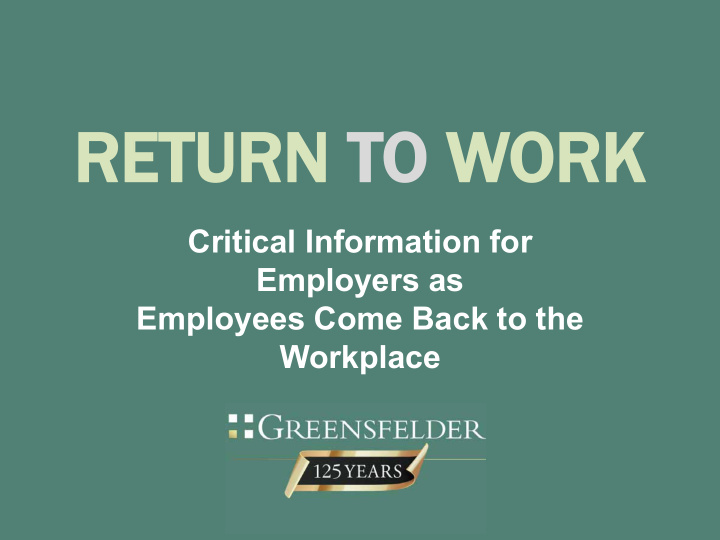



RETURN TO WORK Critical Information for Employers as Employees Come Back to the Workplace
How Prepared Are You? A full Working Empty plan! on it ... so far ...
Today’s Panelists
Overview Return to work after stay-at-home orders are lifted The new normal: workplace reintegration plans Medical testing of employees and other screening Managing COVID in the workplace OSHA considerations Visitors, customers, clients, vendors Ongoing remote work, wage and hour reminders
Return to work after orders are lifted The new normal: workplace reintegration plan Medical testing of employees and other screening Managing COVID in the workplace OSHA considerations Visitors, customers, clients, vendors Ongoing remote work, wage and hour reminders
When Can You Require? Step 1 – Step 2 - Step 3 - Guidance from State and local Individual job CDC, OSHA, return to work needs. DOL, EEOC orders
When Can’t You Require? FFCRA Leave EPSL / EFMLEA (< 500) FMLA Need Accommodation (ADA/PDA/State Law)
Is YOUR Business Ready? A Marathon, Not a Sprint • Workplace safety • Voluntary callbacks • Shifts, Shortened workweeks • Flexible work arrangements, telework • Non-discriminatory, objective criteria
I can’t return because ... • I am high risk. • I fear getting sick. • my spouse is high risk. • school/daycare is closed. • I will make more on unemployment.
Consider Policies Leave policies Temporary policies Train managers Monitor often to keep consistent with CDC guidelines
Return to work after stay-at-home orders are lifted The new normal: workplace reintegration plan Medical testing of employees and other screening Managing COVID in the workplace OSHA considerations Visitors, customers, clients, vendors Ongoing remote work, wage and hour reminders
Implement Workspace Controls Engineering Administrative Safe work controls controls practices
Infection Prevention Measures • Develop daily sanitization regimen • Provide disinfecting wipes or spray / paper towels • Hand sanitizer and tissues • Document what you are doing
Reorganize Workspace as Necessary • Revamp crowded seating areas • Eliminate shared workstations • Mark 6- foot distances
Maximum Occupancy: Maximum Occupancy: 1 person 1 person • Limit number of employees in common • Limit number of employees areas in common areas • Stagger break times and lunch schedules • Stagger break times and • Establish protocols for using bathrooms, lunch schedules stairwells and elevators • Establish protocols for using bathrooms, stairwells and elevators
Sharing is not caring 1. Discourage shared use of lunchroom appliances 2. Prohibit food sharing 3. Reconsider file and document sharing and handouts
Monitor Employee Movement Monitor Employee Movement • Personal travel • Personal travel • Business travel • Business travel • Employees entering and leaving the office • Employees entering and • Movement between departments leaving the office • Movement between departments
Encourage Safety on the Commute to Work • Prohibit ride-sharing and carpooling • Incentivize employees to avoid public transportation • Require precautionary measure if public transportation must be used
Return to work after stay-at-home orders are lifted The new normal: workplace reintegration plan Medical testing of employees and other screening Managing COVID in the workplace OSHA considerations Visitors, customers, clients, vendors Ongoing remote work, wage and hour reminders
Legal Framework • ADA requires medical tests be: 1. Job-related and 2. Consistent with business necessity • EEOC says COVID-19 is direct threat • GINA considerations
What is Medical Test/Inquiry? • Temperature checks • COVID-19 testing • Screening questionnaire before each work shift • Fitness for duty • Anti-body testing
Protecting Medical Information Separate from personnel file Limit access COVID-19 can be in existing medical file Includes employee statements/questionnaires
Return to work after stay-at-home orders are lifted The new normal: workplace reintegration plan Medical testing of employees and other screening Managing COVID in the workplace OSHA considerations Visitors, customers, clients, vendors Ongoing remote work, wage and hour reminders
Employer Checklist Experiences Employee tests symptoms associated OR positive with COVID-19 Mandatory Last day in the exclusion from the Close contact workplace workplace.
Return to work after stay-at-home orders are lifted The new normal: workplace reintegration plan Medical testing of employees and other screening Managing COVID in the workplace OSHA considerations Visitors, customers, clients, vendors Ongoing remote work, wage and hour reminders
OSHA Worker Exposure Risk Very high or high exposure risk Medium exposure risk Low exposure risk
Personal Protective Equipment (“PPE”) • Very high or high exposure risk – Gloves, gown, face shield, goggles, face mask, respirator • Medium exposure risk – Some combination of gloves, gown, face mask and/or face shield and goggles • Low exposure risk
If an employee is diagnosed with COVID-19, must an employer treat it as an OSHA recordable incident? It depends. • OSHA “Enforcement Guidance for Recording Cases of Coronavirus Disease 2019 (COVID-19” April 10, 2020. https://www.osha.gov/memos/2020-04-10/enforcement- guidance-recording-cases-coronavirus-disease-2019-covid-19#ftn2 • Health care industry, emergency response organizations, and correctional institutions • Other employers • Focus on good hygiene practices and mitigating the effect of the virus
If an employee is diagnosed with COVID-19, must an employer treat it as a worker’s compensation injury or illness? It depends on state law
Return to work after stay-at-home orders are lifted The new normal: workplace reintegration plan Medical testing of employees and other screening Managing COVID in the workplace OSHA considerations Visitors, customers, clients, vendors Ongoing remote work, wage and hour reminders
It’s Not Just Employees ... Limit face-to-face interaction Set appointments Require screening
Return to work after stay-at-home orders are lifted The new normal: workplace reintegration plan Medical testing of employees and other screening Managing COVID in the workplace OSHA considerations Visitors, customers, clients, vendor s Ongoing remote work, wage and hour reminders
Recognize the Wage and Hour Risks of Remote Work • Capture all the time worked • Document the expectation • Ensure timekeeping policies are clear
Contact Us
More Resources For updates, visit: • Greensfelder COVID-19 Resources page: https://www.greensfelder.com/ covid-19-resources.html • SimplyHR Blog: https://www.greensfelder.com/ employment-and-labor-blog
THANK YOU! THANK YOU! Legal Disclaimer: This document is not intended to give legal advice. It is comprised of general information. Employers facing specific issues should seek the assistance of an attorney.
Recommend
More recommend